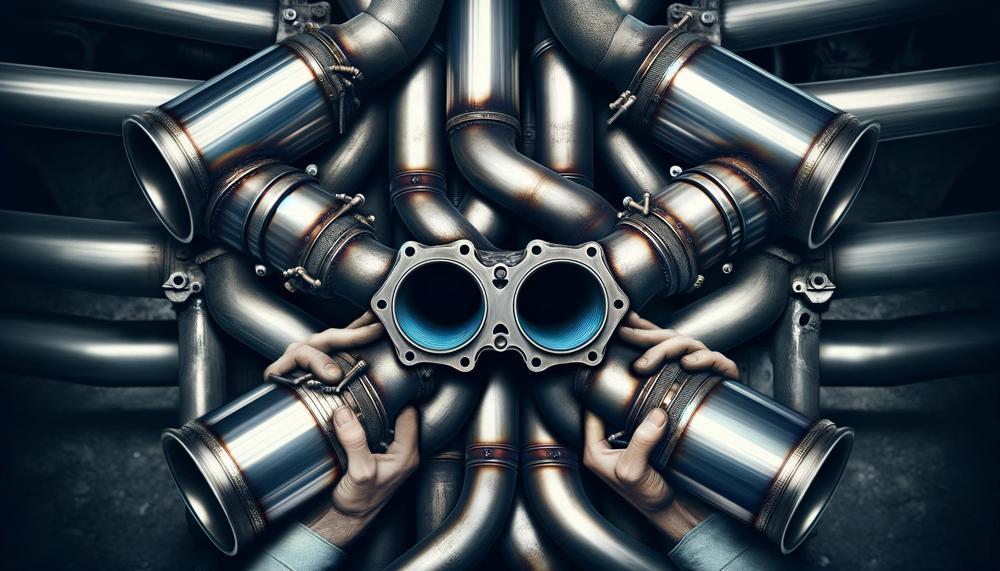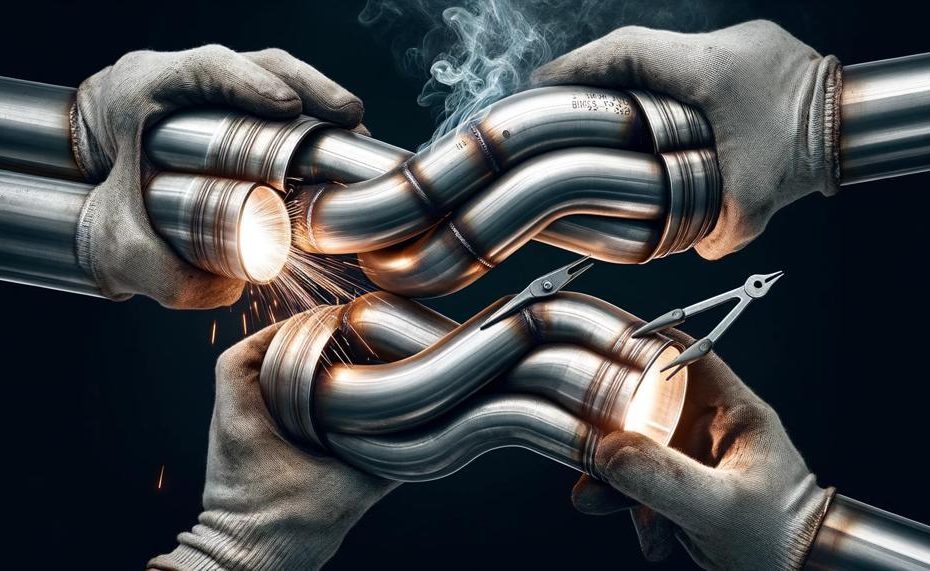Are you someone who loves cars or enjoys fixing things yourself and wants to take on exhaust system repairs without the need for welding? Welcome to our comprehensive guide exploring the cutting-edge techniques for connecting exhaust pipes without the need for traditional welding methods.
If you’re hesitant about welding because of its intricacy, expense, or lack of equipment, this article is here to help.
We’ll delve into the intricate details of different options that offer a reliable, long-lasting, and tight connection between your exhaust components.
Here’s what we’ll cover:
- Clamping Techniques: Discover the ins and outs of using different types of exhaust clamps, their installation process, and how to ensure a tight seal.
- Exhaust Adhesives: Get to grips with high-temperature exhaust sealants and how they can be a game-changer in sealing joints without a welder.
- Band Sleeves and Butt Joints: Understand how these fittings work to create a strong, weld-free bond between pipes.
- Precautions and Tips: Learn the dos and don’ts to avoid common pitfalls and ensure a successful, long-lasting repair.
By the end of this article, you’ll be equipped with the knowledge and confidence to repair or modify your exhaust system safely and effectively, without the need for welding. So, buckle up, and let’s dive into the world of exhaust repair the weld-free way.
Contents
- 1 What is Joining Exhaust Pipes Without Welding?
- 2 Advantages of Joining Exhaust Pipes Without Welding
- 3 Different Methods for Joining Exhaust Pipes without Welding
- 4 Clamps for Joining Exhaust Pipes without Welding
- 5 Sleeves for Joining Exhaust Pipes without Welding
- 6 Adhesives for Joining Exhaust Pipes without Welding
- 7 Conclusion
What is Joining Exhaust Pipes Without Welding?
Joining exhaust pipes without welding involves methods like clamps, sleeves, and adhesives. These techniques allow for efficient, cost-effective connections while providing flexibility and ease in maintenance.
Each method has unique characteristics suited to different exhaust system requirements.
| Method | Advantages | Considerations |
| Clamps | Versatile, easy installation | Not as robust as welding |
| Sleeves | Aesthetic, adaptable to sizes | May not suit high-performance use |
| Adhesives | Strong bond, permanent | Limited by heat and stress levels |
The choice of method depends on factors like strength, durability, and compatibility with the exhaust system. Clamps offer simplicity and flexibility, sleeves provide a clean finish, and adhesives ensure a lasting bond.
When compared to welding, these non-welded methods save costs on equipment and skilled labor, simplify maintenance and repairs, and allow for greater customization in exhaust system design.
Advantages of Joining Exhaust Pipes Without Welding
Opting for non-welding techniques in joining exhaust pipes brings several advantages. These methods save coin and tick by sidestepping the need for heavy-duty gear and seasoned workers. They offer flexibility, letting mechanics mix and match pipes of diverse sizes and materials.
The ease of maintenance, alongside the tweakable nature of these connections, adds to their appeal. Additionally, they often lead to a tidier look, stand up well under extreme heat and pressure, and when executed with precision, result in sturdy, reliable unions.
| Saves time and money | Avoids costly welding equipment and expert labour | Quick, cost-efficient solution |
| Versatility | Connects varying pipe sizes/materials | Adaptable to different systems |
| Easier maintenance and customization | Simplifies alterations and repairs | Enhances vehicle’s adaptability |
| Aesthetic appeal | Cleaner finish than welding | Boosts visual aspect of the exhaust system |
| Easy disassembly | Standard tools for removal | Convenient for future modifications |
| Withstands extreme conditions | Suitable for high-performance engines | Reliable under high temperature/pressure |
| Secure and durable connection | Strong bond when fitted properly | Long-lasting exhaust integrity |

By embracing these methods, car enthusiasts and mechanics can ensure their vehicles run smoother without splashing out on welding operations.
Different Methods for Joining Exhaust Pipes without Welding
To mate exhaust pipes sans the heat and fusion of welding, you’ve got a trio of nifty methods up your sleeve.
Each brings its own flair to the table, ensuring your exhaust setup not only stands firm but also boasts the flexibility to tweak and turn as your ride demands. Let’s dive into the specifics, shall we?
| U-bolts | These sturdy little numbers wrap around your pipe, tightening into place with nuts. They’re the go-to for a quick fix, offering a solid grip that’s easy on the wallet. Perfect for those looking for a steadfast solution without the frills. | Quick, cost-effective, secure |
| Band Clamps | A sleeker, more polished choice, band clamps encircle your exhaust pipes, clamping down with a snug fit that leaves no marks. Ideal for those yearning for a cleaner look and a bond that’s as tight as your pipes are round. | Clean finish, no pipe distortion, reusable |
| Flex Pipes | Introduce a bit of give in your system with flex pipes. These adaptable fellows absorb vibrations, making them a must for any rig that’s all about smooth rides and longevity. A choice pick for the practical enthusiast keen on keeping things running without a hitch. | Vibration absorption, durability, flexibility |
Selecting the right method hinges on your specific needs—whether it’s a bulletproof bond, a seamless look, or a bit of bounce in your exhaust system.
Clamps for Joining Exhaust Pipes without Welding
Joining exhaust pipes without welding can be a savvy choice for both the seasoned mechanic and the weekend garage tinkerer.
The clamps listed below offer a sturdy and reliable method for securing exhaust connections without the permanence or expertise required for welding.
| Type of Clamp | Description | How It Works |
|---|---|---|
| U-Bolt Clamps | Sturdy, U-shaped bolts with a plate that fits across the pipe’s diameter. | They wrap around the pipe, securing it tightly against a mating surface with nuts tightened on the bolts, providing a firm grip. |
| Band Clamps | A strap of metal that encircles the pipes, often equipped with a sealing gasket. | When tightened, the band exerts uniform pressure around the joint, sealing without crimping or damaging the pipes. |
| V-Band Clamps | Consist of two flanges that are welded to the ends of the pipes and a clamping mechanism. | The clamp locks the flanges together, creating a secure and easily disassembled joint, ideal for custom and high-performance applications. |
| Sleeve Clamps | A tube or sleeve that fits over the ends of two pipes, secured with smaller clamps or fasteners at each end. | It bridges and seals the gap between pipes, allowing for slight movements and adjustments without leakage. |
These clamping methods are favoured for their adaptability to different sizes and shapes of exhaust pipes, ease of installation, and the flexibility they offer for future modifications or repairs.
Sleeves for Joining Exhaust Pipes without Welding
Sleeves, in the realm of exhaust repair and modification, emerge as sturdy metal tubes crafted to snugly slide over the extremities of exhaust pipes, thus bridging them without the need for traditional welding.
Let’s cut through the fog and simplify how these clever contraptions work and why they’re a go-to for many automotive enthusiasts and mechanics alike.
Sleeves: A Simple yet Effective Solution
At their core, sleeves are about simplicity and efficiency. Manufactured from resilient materials like stainless or aluminized steel, these tubes are designed to withstand the harsh conditions of exhaust systems. Here’s a straightforward breakdown of their role:
- Material Toughness: Opt for stainless steel for its defiance against rust or aluminized steel for a balance of durability and cost-effectiveness.
- Sealant Application: A swipe of high-temperature silicone sealant on the pipe ends ensures a leak-proof union, marrying functionality with reliability.
- Aesthetics and Flexibility: Beyond their primary function, sleeves offer a sleek look and adaptability in design, trumping traditional clamps or ties in both form and function.
The Process: How to Unite Exhaust Pipes sans Welding
Marrying exhaust pipes with sleeves isn’t just about shoving one end into another. It demands finesse, a bit of elbow grease, and attention to detail. Here’s the gist of it:
- Cleanliness is Next to Godliness: Kick off with pristine pipe ends to ensure nothing interferes with the bond.
- Seal the Deal: Apply that high-temperature silicone sealant we talked about, not skimping but not overdoing it either.
- Slide and Secure: With the sealant in place, slide the sleeve over the pipe ends. It’s like putting on a tight jacket – snug but fitting.
Table: Quick Glance at Sleeve Joining Essentials
| Material | Sealant Type | Key Benefit |
| Stainless Steel | High-Temperature Silicone | Rust Resistance |
| Aluminized Steel | High-Temperature Silicone | Cost-Effectiveness |
| Aesthetic Appeal | Flexibility in Design | Easy Disassembly |
Adhesives for Joining Exhaust Pipes without Welding
Adhesives for joining exhaust pipes without welding come with their set of perks and hitches, much like any clever fix out there. These sticky solutions offer a straightforward way to tackle the task at hand, yet they aren’t without their challenges.
| Benefits | Drawbacks |
| Time and cost savings compared to welding. | Potential necessity for welding in high-stress situations. |
| Versatility for pipes of varying sizes and materials. | Surface prep must be thorough; grease or oil can weaken bonds. |
| High-temperature silicone and two-part epoxy create robust, lasting bonds. | Bonds might not match the strength and leak resistance of welded joints. |
| Sleeker appearance than clamps or ties. | |
| Can seal joints and connections to prevent leaks. |
Opting for adhesives can indeed save a penny and a minute, making them a handy alternative to the old weld and grind. They’re a dab hand at connecting pipes of differing characters and keeping things looking tidy. Yet, they demand a clean slate to start with – any slick or grime can spell trouble for the bond.
While they’re tough, they may not always stand up to the rigours that a welded joint would laugh off, and a slip in application technique might just let the smoke out.
Conclusion
In the ever-changing field of car maintenance, the search for inventive methods to connect exhaust pipes without the need of welding has revealed a vast array of potential options.
This tutorial has explored a wide range of non-welding techniques, highlighting the usefulness and cleverness of clamps, sleeves, and adhesives. These approaches provide relief from the intricate and costly aspects of welding, while also allowing for artistic and adaptable alterations to exhaust systems.
Each approach, from the firm grasp of different clamps to the smooth connection of sleeves and the strong adhesion of high-temperature sealants, has its own distinct benefits, designed to meet specific requirements and situations. Exploring these options showcases a seamless combination of visual appeal, long-lasting quality, and economical value, motivating both enthusiasts and do-it-yourself mechanics to adopt these methods that do not need welding.
In conclusion, it is evident that the technique of connecting exhaust pipes without welding goes beyond just avoiding conventional ways. It involves leading the way via innovation, guaranteeing dependability and efficiency, and addressing the unique requirements of each vehicle.





